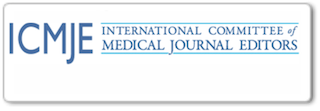The Assessment of Muscle Strength in Fracture Patients with Manual Muscle Testing: Narrative Literature Review
Abstract
Decreased muscle strength in fracture patients can be caused by postoperative immobilization, thus requiring early immobilization to accelerate the fracture healing process. The principle of early immobilization is the same as the assessment of muscle strength, namely flexion, extension, and rotation to determine muscle strength in fracture patients. To determine the decrease in muscle strength with the Manual Muscle Testing (MMT) method in fractured and non-fractured patients. Narrative literature review was chosen in this research design. Literature search through seven databases with keywords using boolean operators and found 6533 articles. The selection process is based on several criteria: the publication year 2015-2020, full-text access, National (SINTA) / International (Scimagojr) indexed articles, in English or Indonesian, so that 11 articles were reviewed in this study. MMT is a reliable measurement tool, does not require additional tools to assess muscle strength and is universal (can assess muscle strength in fractures and non-fractures). MMT examination needs to be performed on fracture patients to determine muscle strength to accelerate the muscle recovery process.
Keywords
References
Adawiyah, A., & Selviastuti, R. (2014). Serburia suplemen tulang ikan bandeng dengan cangkang kapsul alginat untuk mencegah osteoporosis. Jurnal Ilmiah Mahasiswa: Fakultas Kesehatan Masyarakat Universitas Diponegoro, 4 (1), 53-59.
Belom Journal of Physical Education and Spor azheva-dimitova, S. (2020). Recovery of the muscle function after stable elbow fractures, 19(06), 2070-2074.
Bertelli, J., Soldado, F., & Ghizoni, M. F. (2018). Outcomes of radial nerve grafting in. journal of hand surgery, 43(12), 1–6.
Bye, E., Glinsky, J., Yeomans, J., Hungerford, A., Chen, L., Harvey, L., Hungerford, A. (2019). The inter-rater reliability of the 13-point manual muscle test in people with spinal cord injury. Physiotherapy Theory and Practice, 37(10), 1126-1131.
Cho, H. M., Lee, H. J., & Lee, H. (2019). Conservative treatment using a sponge cast for transfer fractures in nursing home patients, Clinical Interventions in Aging, 14, 1361–1369.
Cuthbert, S. C., & Jr, G. J. G. (2007). Chiropractic & Osteopathy review. BioMed Central, 23, 1–23.
Don, J., Cnor, B. R., & Faan, C. N. E. N. (2016). The purpose, process, and methods of writing a literature review. association of registered nurses, 103(3), 265–269.
Gao, Q., Leung, A., Reinhardt, J. D., Zhang, F., Liang, Q., Chen, B.,He, H. (2015). Health-related Quality of life of fracture victims four years after the 2008 Sichuan earthquake. Journal of Rehabilitation Medicine, 47(9), 867-872.
Gayatri Ramesh Patane, Smita Bhimrao Kanase, Khushboo JyotindraBathia, C. B. P. (2019). Effect of the Traditional Toys Exercises as an Adjunct to Hand Therapy Following Post-Traumatic Forearm Bone Fracture in Children. Indian Journal of Physiotherapy and Occupational Therapy, 13(4), 1-222.
Iwamoto, T., Suzuki, T., Matsumura, N., Nakamura, M., Matsumoto, M., & Sato, K. (2017). Lateral Para-Olecranon Approach for the Treatment of Distal Humeral Fracture. Journal of Hand Surgery, 42(5), 344-350.
Khosrojerdi, H., Tajabadi, A., Amadani, M., Akrami, R., & Tadayonfar, M. (2018). The effect of isometric exercise on pain severity and muscle strength of patients with lower limb fractures : a randomized clinical trial study, 7(1), 1-5.
Kurniasari, S. D. (2010). Penatalaksanaan terapi latihan pada kondisi paska operasi pertrokanter femur dekstra. Jurnal Pena, 19(1), 48–57.
Lee, J., Kim, J., & Lee, B. (2017). The effects of posterior talar glide with dorsiflexion of the ankle on mobility, muscle strength and balance in stroke patients: a randomised controlled trial, Journal of Physical Therapy Science, 29(3), 452-456.
Naoki Kondo, Junichi Fujikawa, Katsumi Arai, Rika Kakutani, N. E. (2018). Sacral Stress Fracture Complicated by L5 Radiculopathy in a Patient with Rheumatoid Arthritis. Acta Medika Okayama, 72(5), 531-534.
Nas, K., Yazmalar, L., Şah, V., Aydin, A., & Öneş, K. (2015). Rehabilitation of spinal cord injuries. World Journal of Orthopaedics, 6(1), 8–16.
Ostermann, R. C., Lang, N. W., Joestl, J., Pauzenberger, L., Tiefenboeck, T. M., & Platzer, P. (2019). Fractures of the Humeral Shaft with Primary Radial Nerve Palsy: Do Injury Mechanism, Fracture Type, or Treatment Influence Nerve Recovery ? Journal of Clinical Medicine, (1), 1–8.
Putranto, T. A., Yusuf, I., Murtala, B., & Wijaya, A. (2016). Intra arterial heparin flushing increases Manual Muscle Test – Medical Research Councils (MMT-MRC) score in chronic ischemic stroke patient, Bali Medical Journal, 5(2), 216-220.
Shah, P. S., & Shinde, S. B. (2018). Effect of desensitization methods during the early mobilization phase in post-fracture conditions of upper extremity. Asian journal of pharmaceutical and clinical research, 11(7), 35–38.
Shinohara, T., Takahashi, S., & Hirata, H. (2017). Anterior interosseous nerve palsy mimicking rupture of the index flexor digitorum profundus after volar locking plate fixation of a distal radius fracture. Nagoya Journal of Medical Science, 79(3), 421–425.
Timothy Kenyon-Smith, D. (2019). Early Mobilization Post-Hip Fracture Surgery. Geriatric Orthopaedic Surgery and Rehabilitation, 10, 1–6.
Zhang Jin-long- HE Hong-chen, LIN Hai-dan, LUO Qing-lu, XIA Lu, L. S. and H. C. (2011). Motor function and activities of daily living capacity of patients with fractures sustained during the Wenchuan earthquake. Chin Med, 10(August), 1504–1507.
DOI: https://doi.org/10.17509/jpki.v7i1.26804
Refbacks
- There are currently no refbacks.
Jurnal Pendidikan Keperawatan Indonesia(JPKI) published by Indonesia University of Education. JPKI is licensed under a Creative Commons Attribution-ShareAlike 4.0 International License.
Office :
Nursing Department. FPOK UPI.
229, Dr. Setiabudhi Street. Bandung 40154
West Java , Indonesia
E-mail : jpki@upi.edu

_.png)
_.png)
_.png)











